Sewing Montages

A few kilometres from Bhubaneshwar, the capital of Orissa, is a village where all houses and shops along the roads have one thing in common: beautiful appliqué work, in the making or on display, all giving out a loud burst of colour. This famous appliqué work comes from Pipli village, which was established by the King of Orissa for accommodating the craftsmen who made appliqué umbrellas and canopies for the annual Jagannath Yatra.

The appliqué craft reached its peak in the 11th century AD, under the patronage of the king and nobility. A craft that originated as a temple art now finds its application in a wide range of household, decorative and ceremonial products. This handicraft is unparalleled in its flexibility and versatility, permitting experimentation and encouraging innovation. Artisans with their skilful blending of myths, symbolism and imagination provide the craft an appealing dynamism.
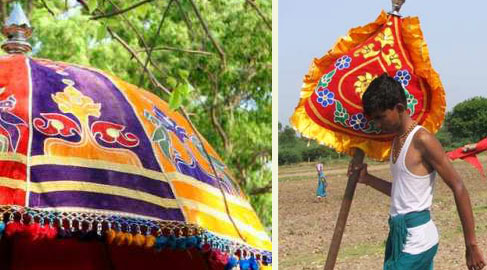
Image Source~www.artbeautysociety.wordpress.com
The appliqué items are mainly used during processions of the deities in their various ritual outings. Items like Chhati (umbrella), Tarasa – a heart-shaped wooden piece covered by appliqué cloth and supported by a long wooden pole and Chandua – an umbrella shaped canopy are usually seen during the processions. ‘Jhalar’, another popular item is a sort of frill which is used as a border to canopies and also independently as a decorative piece.
However, the appliqué work in its colourful best is most prominent in the cloth covers of the three chariots of the presiding deities in which they travel every year during the Ratha Yatra or Car Festival. As per tradition, the colour scheme of the three covers is predetermined, green and red for the chariot of Balabhadra, black and red for that of Subhadra and yellow and red for Lord Jagannath’s chariot.
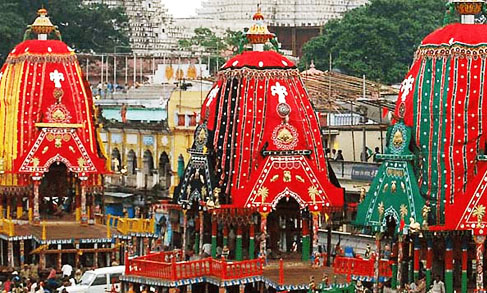
The basic design of all three is similar, being a combination of narrow and wide stripes while on the four sides above the openings, there are appliquéd mythical motifs like Rahu, Chandra as well as motifs from nature. It is these eye catching appliqué covers which help identify the chariots of the three deities from far away when thousands of pilgrims throng the main road of Puri on which the gods make their annual sojourn in the chariot festival. Appliqué work is also used in making seats and pillows for the deities and also for their ritual dresses.
The craft is traditionally practiced by a community of professional tailors, known as ‘Darjis’. Their beautiful work is considered a service for the Lord, or “seva”. The community, led by a chief, is well organized, with annual meetings to resolve any social or other problems.
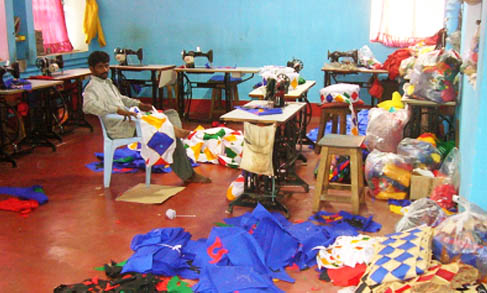
Appliqué comes from the French word “appliquer”, which means to “put on”. In appliqué, one piece of fabric is placed over a base layer and is sewn in place. Another technique is the reverse appliqué, in which one layer of fabric is placed on another layer, and a shape is cut out from the top layer, exposing the lower layer. These two are then neatly stitched together.
The base cloth, that includes waterproof material for umbrellas, velvet for tents, and cotton, is sourced from Kolkata and threads, locally called “Sutta”, are sourced from Surat. Since the designated colours for ceremonial pieces are limited, craftsmen find an outlet to their creativity in combining these colours in different proportions and combinations.
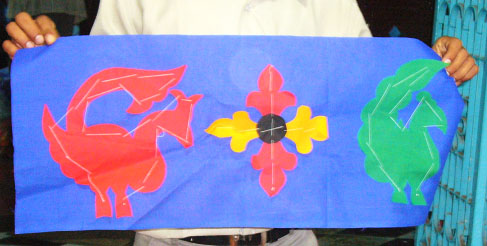
The motifs used consist of stylized representations of flora and fauna as well as a few mythical figures. Of the more common of these motifs are the elephant, parrot, peacock, ducks, creepers, trees, flowers like lotus, jasmine, half-moon, the Sun and Rahu (a mythical demon who devours the sun).
Flat motifs are first cut from cloth and then superposed on the base cloth in a predetermined layout and sequence. The edges of the motifs are turned in and skilfully stitched onto the base cloth or stitched by embroidery or without turning as necessary. Craftsmen use straight stitch, blind stitch, satin stitch or buttonhole stitch for attaching the pieces of cloth. Sometimes they also make use of decorative stitches and mirror work for more elaborate pieces.
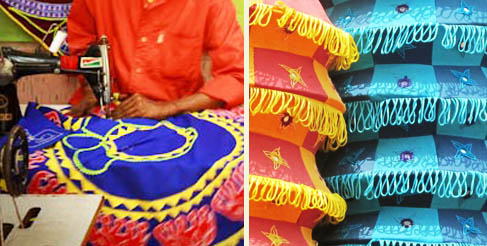
A characteristic style of the Orissa appliqué involves three dimensional patterns made by folding of the upper piece of cloth into triangles and attaching them to the base.
While there has been very little change in the use of motifs, there is a trend towards greater experimentation in colour for non ceremonial items such as bags, cushion covers, bed sheets etc. Appliqué items are also being used in combination with other crafts to produce composite products. An interesting new use is the superimposition of appliqué on grass mats and used as partitions. .
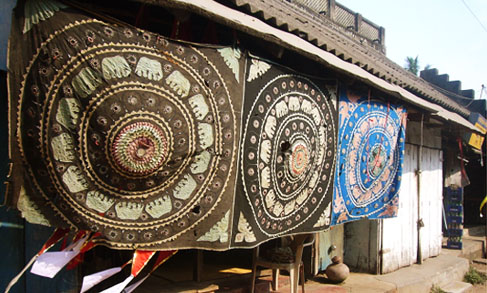
From grand sanctified ceremonial items in prescribed colours and designs, to small souvenirs and utility products for an urban dweller, the craftsmen of Pipli have mastered the art of creating the most attractive objects from simple pieces of cloth.
text by: Sana Karmali

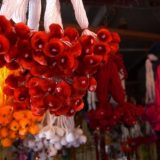
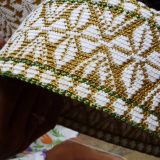








Nithyaprakash.V
exploring pipli art forms to improve texture depth in designs